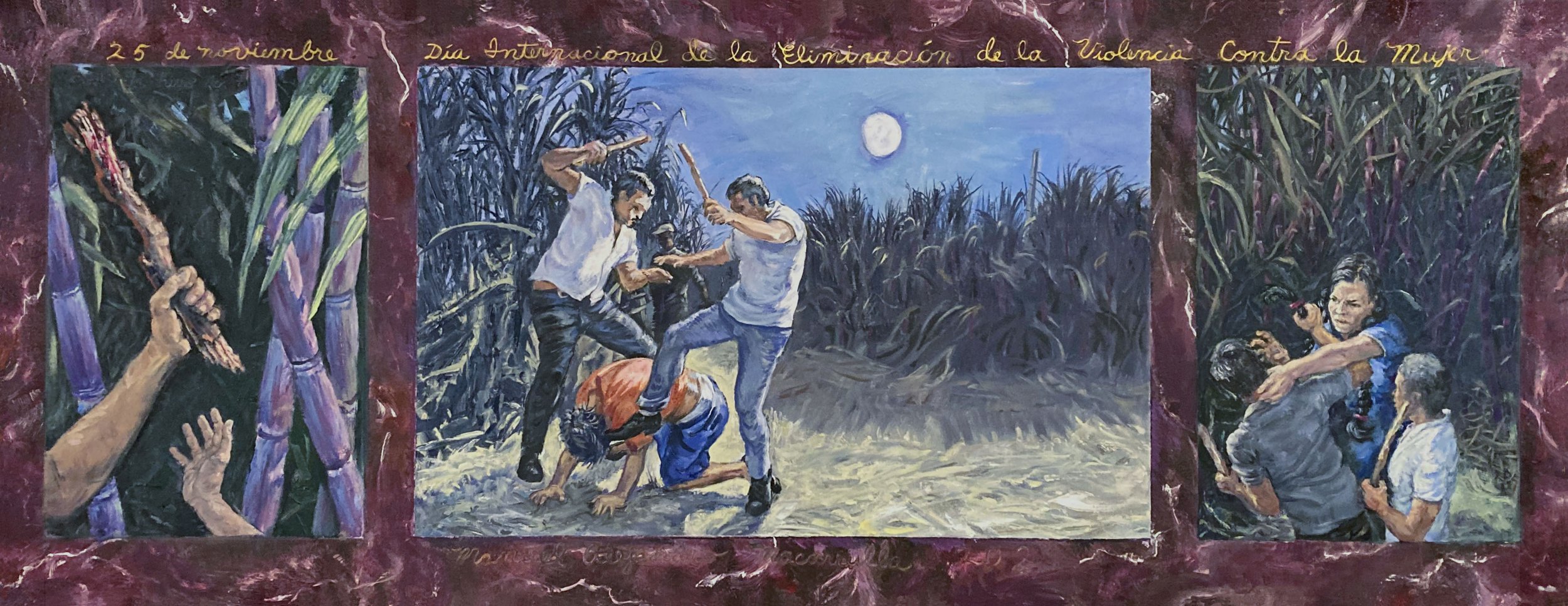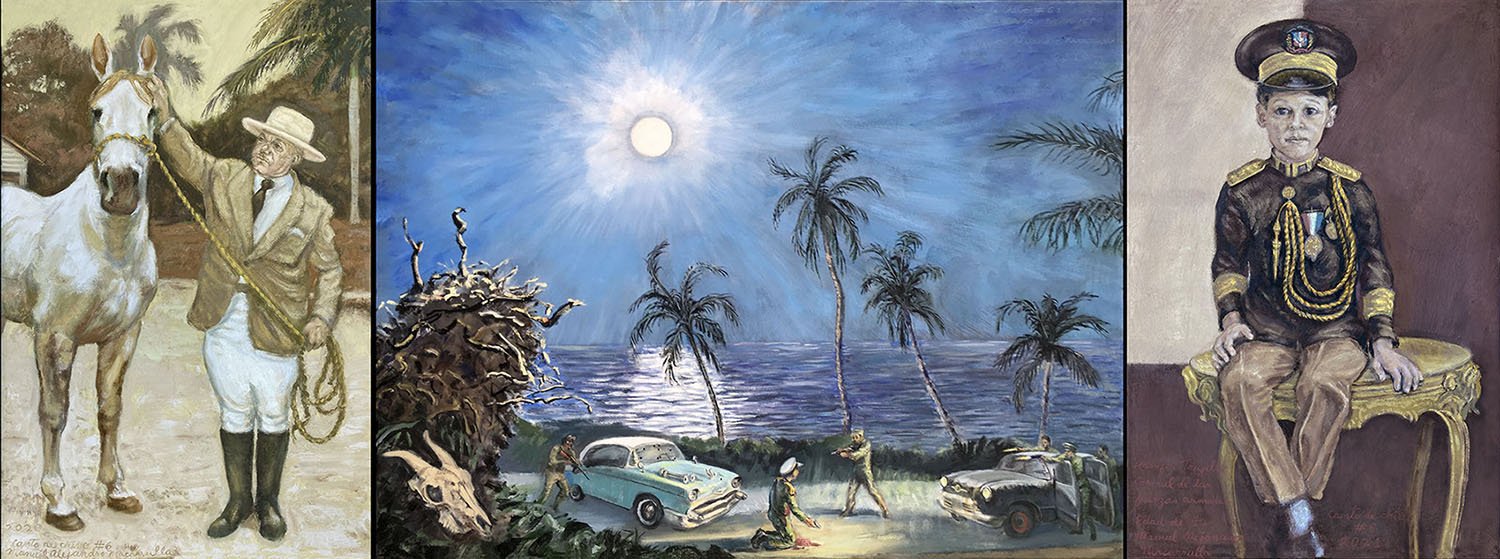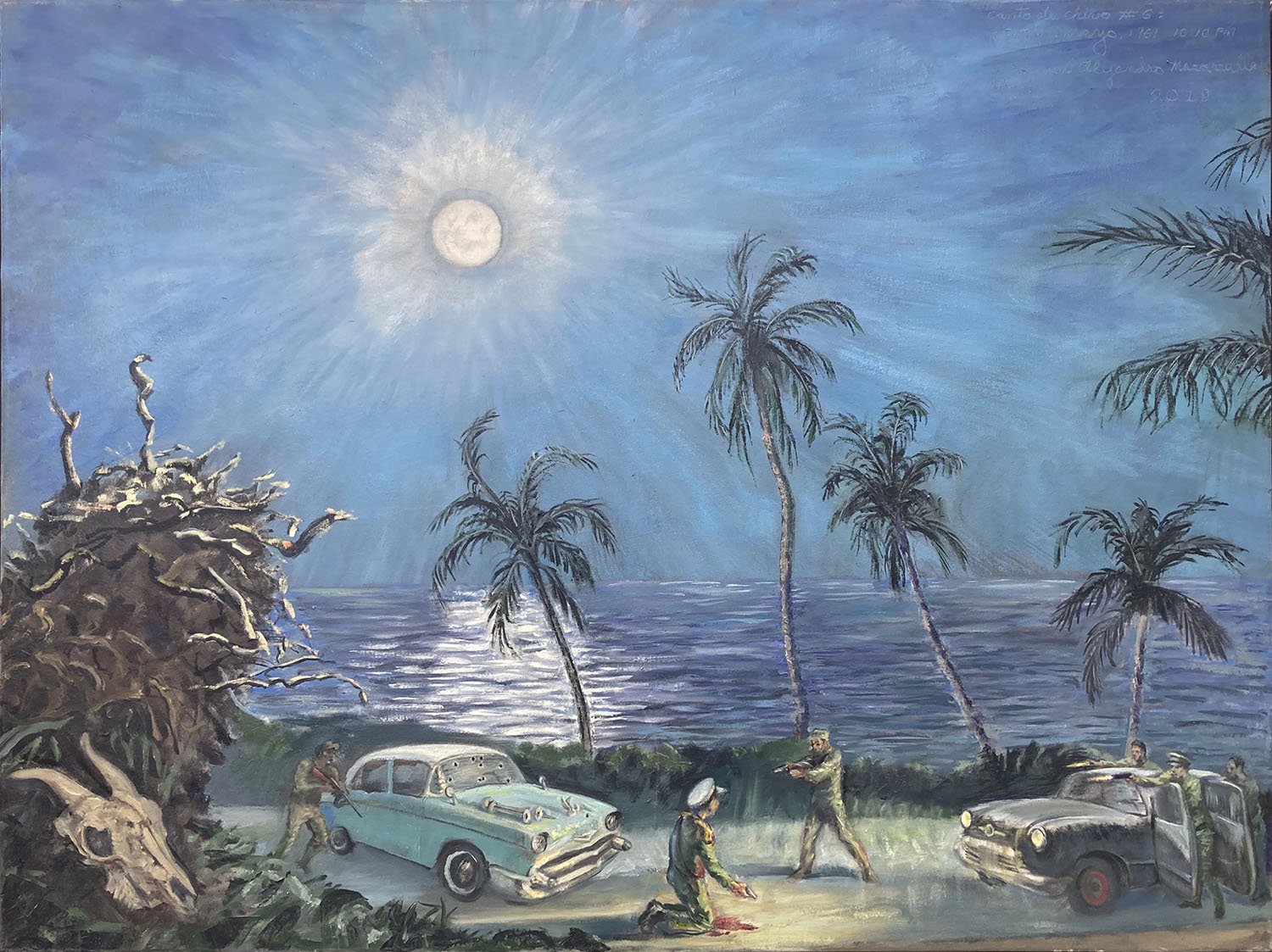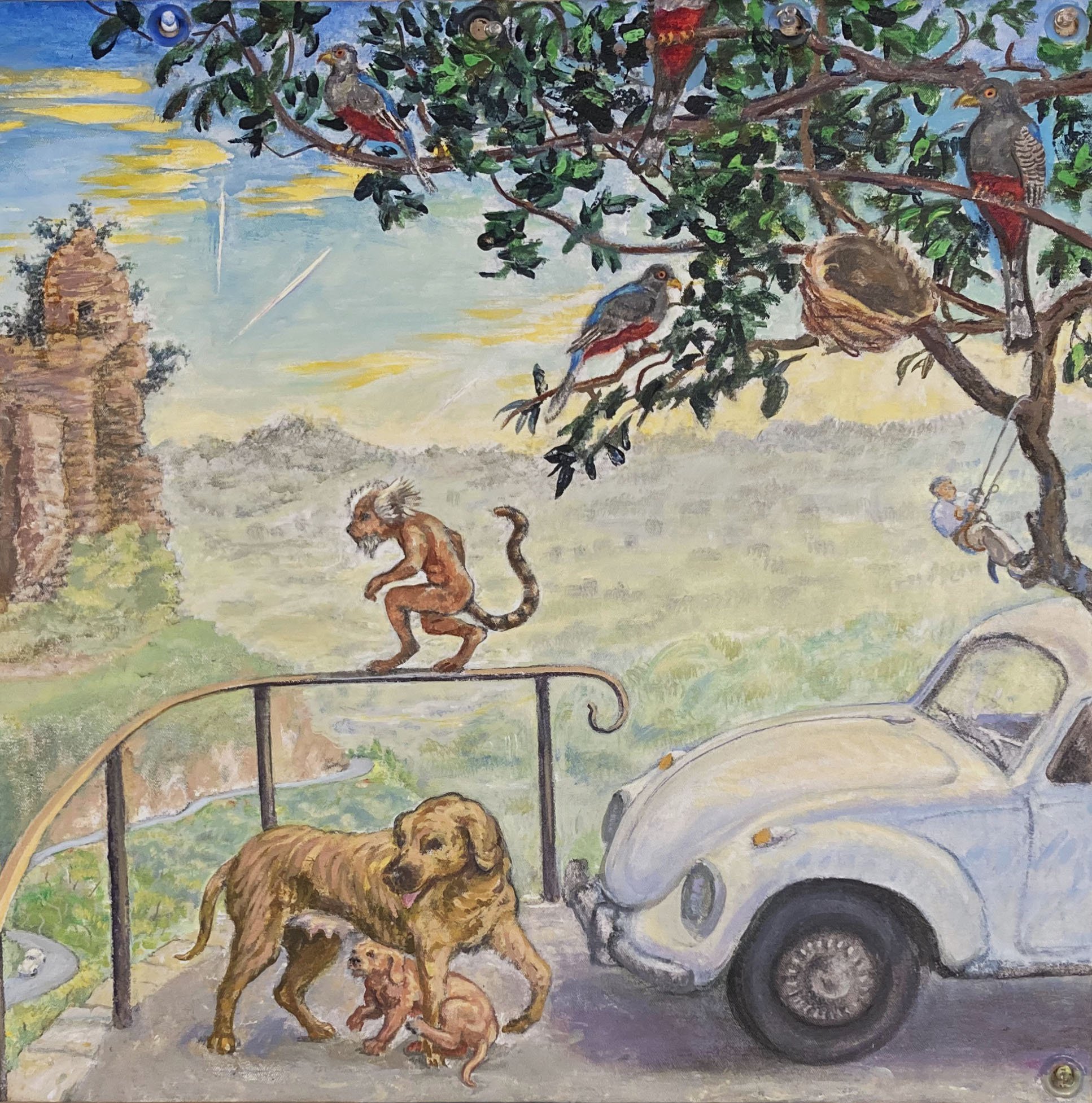


Goat Song (Canto de chivo) No. 10: Rededication, 2020
Oil on canvas. Tondo, 39.25” diameter. (Collection of Dirección de Cultura Dominicana en el Exterior.)
![Goat Song No. 9: Dedication, 2024. Oil on canvas. 30” diameter. Inscription: Obelisk erected by the Dominican people in commemoration of the first anniversary of the change of name of the city of Santo Domingo to Trujillo City [1937].](https://images.squarespace-cdn.com/content/v1/586da56237c5817265cf81c2/1730128998966-RZZRH2TS1960Q88TNORS/Goat+Song+No.+9+Dedication_2024_Oil+on+canvas_30+in.+diameter.jpg)
Goat Song No. 9: Dedication, 2024.
Oil on canvas. 30” diameter.
Inscription: Obelisk erected by the Dominican people in commemoration of the first anniversary of the change of name of the city of Santo Domingo to Trujillo City [1937].


Goat Song (Canto de chivo) #7: November 25th: International Day to End Violence Against Women (Triptych), 2021.
Oil on Canvas. 26” X 66”.

Goat Song (Canto de chivo) #7: November 25th: International Day to End Violence Against Women (right panel), 2021.
Oil on Canvas. 26” X 66”.


Goat Song No. 6: May 30th, 1961, 2021.
Oil on canvas. 48” X 96”.

Goat Song #6: May 30th, 1961 (center panel), 2021.
Oil on canvas. 48” X 96”.

Goat Song # 5: Tumult on George Washington Avenue, 1988.
Oil on canvas. 72" X 96".
(Collection of El Museo del Barrio).
Though this is, ostensibly, simply a carnival parade, the presence of the obelisk and the formal name of the street on which it takes place, "George Washington Avenue," both refer to U. S. power and influence.

Goat Song #4: Tie a Yellow Ribbon, 1991
Oil on linen. 96" X 48".
Though this image was inspired by the US invasion of Grenada, in 1983, it nevertheless relates to U. S. backing of Trujillo's rule (Trujillo ascended to power after one U. S. inetervention, and the U. S. destabilized the first democratically elected leader after Trujillo, leading to another U. S. military intervention in 1965).

Goat Song #3: They Shall Not Pass, 1988.
Oil on linen. 96" X 192"
This image was inspired by the initial idealism of the Nicaraguan revolution, and the onslaught it endured from the U. S. backed Contra forces. Eventually, as it became apparent that the Nicaraguan regime was perpetrating its own repressiveness, I disavowed my support for it and destroyed the painting.

Goat Song #2: The Goat Feast (Canto de chivo #2: La fiesta del chivo), study, 1986.
Oil on canvas. 20" X 20". (Private collection.)
This image was the first one I took on, inspiring the entire series, though it was the second one I completed. It takes its title from the song celebrating Trujillo's death. But, in my jocular approach, the "goat" becomes the celebrant, rather than the object of political violence. There was a version of this image on the scale of 68" X 72," now discarded as unsuccessful.

Goat Song # 1: Struggle, 1986
Oil on canvas. 88" X 105"
(Collection of The Studio Museum in Harlem.)
This image is largely inspired by drawings made by Salvadoran refugee children, detailing the atrocities perpetrated against their families by government death squads.


Capricho No. 1 (detail), 2023.
Acrylics on canvas (unstretched-banner format). 27.5” X 70”.

Capricho No. 1 , 2023.
Acrylics on canvas (unstretched-banner format). 27.5” X 70”.

Unionist, 1985.
Oil on canvas. 48” X 72”.
Inspired by information quoted from the US Congressional Record and published by Noam Chomsky, indicating concessions granted to the Dominican Government by US Corporations (Gulf and Western figured prominently in these reports) in exchange for harsh suppression of union activities during the Balaguer presidency. Congressional hearings on these practices led Gulf and Western to divest its Dominican holdings in 1984.

Unionist, 1985.
Installation shot, “Political Paintings,” P. S. 1, Long Island City, NY, October to December, 1986.

Chavón River, 1984.
Oil on canvas. 64” X 48”.





![Goat Song No. 9: Dedication, 2024. Oil on canvas. 30” diameter. Inscription: Obelisk erected by the Dominican people in commemoration of the first anniversary of the change of name of the city of Santo Domingo to Trujillo City [1937].](https://images.squarespace-cdn.com/content/v1/586da56237c5817265cf81c2/1730128998966-RZZRH2TS1960Q88TNORS/Goat+Song+No.+9+Dedication_2024_Oil+on+canvas_30+in.+diameter.jpg)



















Goat Song (Canto de chivo) No. 10: Rededication, 2020
Oil on canvas. Tondo, 39.25” diameter. (Collection of Dirección de Cultura Dominicana en el Exterior.)
Goat Song No. 9: Dedication, 2024.
Oil on canvas. 30” diameter.
Inscription: Obelisk erected by the Dominican people in commemoration of the first anniversary of the change of name of the city of Santo Domingo to Trujillo City [1937].
Goat Song (Canto de chivo) #7: November 25th: International Day to End Violence Against Women (Triptych), 2021.
Oil on Canvas. 26” X 66”.
Goat Song (Canto de chivo) #7: November 25th: International Day to End Violence Against Women (right panel), 2021.
Oil on Canvas. 26” X 66”.
Goat Song No. 6: May 30th, 1961, 2021.
Oil on canvas. 48” X 96”.
Goat Song #6: May 30th, 1961 (center panel), 2021.
Oil on canvas. 48” X 96”.
Goat Song # 5: Tumult on George Washington Avenue, 1988.
Oil on canvas. 72" X 96".
(Collection of El Museo del Barrio).
Though this is, ostensibly, simply a carnival parade, the presence of the obelisk and the formal name of the street on which it takes place, "George Washington Avenue," both refer to U. S. power and influence.
Goat Song #4: Tie a Yellow Ribbon, 1991
Oil on linen. 96" X 48".
Though this image was inspired by the US invasion of Grenada, in 1983, it nevertheless relates to U. S. backing of Trujillo's rule (Trujillo ascended to power after one U. S. inetervention, and the U. S. destabilized the first democratically elected leader after Trujillo, leading to another U. S. military intervention in 1965).
Goat Song #3: They Shall Not Pass, 1988.
Oil on linen. 96" X 192"
This image was inspired by the initial idealism of the Nicaraguan revolution, and the onslaught it endured from the U. S. backed Contra forces. Eventually, as it became apparent that the Nicaraguan regime was perpetrating its own repressiveness, I disavowed my support for it and destroyed the painting.
Goat Song #2: The Goat Feast (Canto de chivo #2: La fiesta del chivo), study, 1986.
Oil on canvas. 20" X 20". (Private collection.)
This image was the first one I took on, inspiring the entire series, though it was the second one I completed. It takes its title from the song celebrating Trujillo's death. But, in my jocular approach, the "goat" becomes the celebrant, rather than the object of political violence. There was a version of this image on the scale of 68" X 72," now discarded as unsuccessful.
Goat Song # 1: Struggle, 1986
Oil on canvas. 88" X 105"
(Collection of The Studio Museum in Harlem.)
This image is largely inspired by drawings made by Salvadoran refugee children, detailing the atrocities perpetrated against their families by government death squads.
Capricho No. 1 (detail), 2023.
Acrylics on canvas (unstretched-banner format). 27.5” X 70”.
Capricho No. 1 , 2023.
Acrylics on canvas (unstretched-banner format). 27.5” X 70”.
Unionist, 1985.
Oil on canvas. 48” X 72”.
Inspired by information quoted from the US Congressional Record and published by Noam Chomsky, indicating concessions granted to the Dominican Government by US Corporations (Gulf and Western figured prominently in these reports) in exchange for harsh suppression of union activities during the Balaguer presidency. Congressional hearings on these practices led Gulf and Western to divest its Dominican holdings in 1984.
Unionist, 1985.
Installation shot, “Political Paintings,” P. S. 1, Long Island City, NY, October to December, 1986.
Chavón River, 1984.
Oil on canvas. 64” X 48”.
